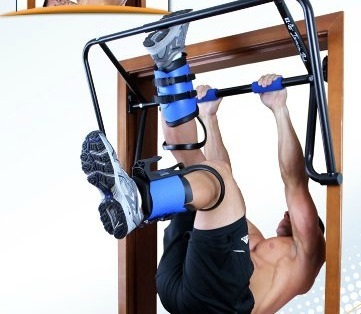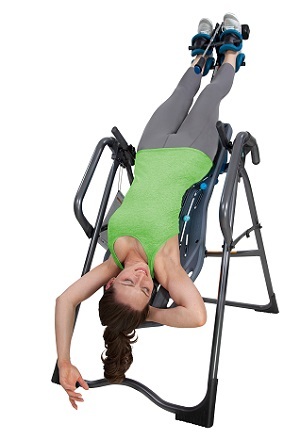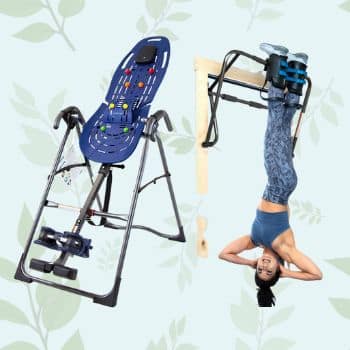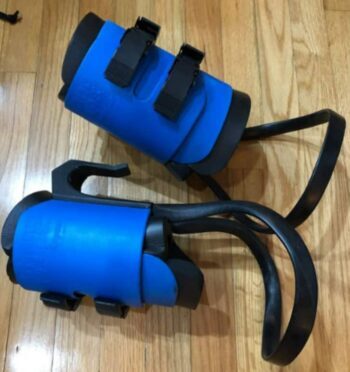Unlike that great song, the Teeter Gravity Boots were NOT made for walking.
They were made for hanging upside down (looking like Batman) and decompressing your spine.
Using inversion boots at home is one of the lowest cost and quickest ways to decompress your spine, and stretch your back and neck muscles.
In this post, you’ll find the pros and cons of the Hang upside boots, how they compare with inversion tables, and our Teeter Gravity Boots review.
This post may contain affiliate links, at no extra cost to you.
Overview
What are Hanging Upside Down Boots?

Gravity boots are basically ankle supporters designed to allow you to hang upside down and fully invert – to decompress your spine. They are made of a durable light shell over thick foam and you can secure them comfortably around each ankle with the self-locking ratchet buckles.
You can use the inversion boots with inversion tables, inverting racks and bars, and even at the gym – on a secure bar – and you can use them to perform inverted exercises like core muscle strengthening and leg workouts.
Teeter Hang Upside Down Boots Benefits
The Teeter inversion boots use gravity to create space between your discs, taking the pressure off them and allowing them to rest and rehydrate (critical for fast healing).
However:
Pain relief is not the only benefit of this simple and natural method. Here are more immediate results:
- Improved blood circulation
- Lymphatic system cleanse
- Stress relief
Plus, unlike inversion tables, Teeter gravity boots allow you to exercise your core muscles while you’re hanging up, which is another shortcut for a complete back pain recovery.
Is Hanging Upside Down Safe?
When using inversion boots, at first, you may feel a little pressure in your head while your body adjusts to the reverse in gravity.
But:
It’s not dangerous and it can be prevented by starting gradually at 30 seconds and increasing to 1-4 minutes at a time.

Generally, hanging upside down is completely safe for most people. In fact, in 2008 stunt master David Blaine hung upside down for 3 full days – without experiencing any type of health problems whatsoever.
His eyes were fine, his blood pressure was fine, and so was everything else.
But, to be on the safe side, if you have high blood pressure, heart disease, or an eye condition, or if you’ve undergone fusion surgery, check with your doctor before you use gravity boots.
Are Inversion Boots Safe?
As for the Teeter inversion boots specifically, no need to worry.
They are well-made, solid, and well-constructed. They fit most ankle sizes and have a double-lock system, which ensures safety and security.
Other features include:
1. Bootstraps that adjust to your ankles, varying several inches in diameter.
2. Removable calf loops that add comfort by placing a two-degree bend in the knees to help reduce load.
3. They are compatible with Teeter Hangups inversion racks, bars, and tables.
Also:
All Teeter devices are FDA Cleared as Class I medical devices for: Back Pain, Sciatica, Muscle Tension, Degenerative Disc Disease, Herniated Discs, Spinal Stenosis, Spinal Curvature Due to Tight Muscles, Muscle Spasm & Facet Syndrome.
Teeter Gravity Boots Pros & Cons
Here are the main advantages of the Teeter inversion boots. Below, you’ll find the cons:
1. Most importantly, quick back pain relief and a speedy recovery from back injuries.
2. They are comfortable to use. They are even comfortable enough to use barefoot. They are easy to put on, and they have a support piece that fits around the back of the leg and foam padding inside the boots.
3. They are lightweight (13 x 9 x 7 inches; 5.07 pounds) and durable. You can safely hang as long as you can endure.
4. You can move and give your core muscles a good workout while you’re hanging. They are awesome to use for relaxing, stretching, and strength training while inverted.
5. They take up much less space than an inversion table.
6. They have a full 5-year warranty
7. They feature calve handles to make it easy to pull yourself up when you’re finished.
8. They are the low-cost yet just-as-effective alternative to an inversion table or your chiropractor.
Check today’s price at Teeter
Cons
A few people would not find the Teeter boots to be a perfect match for them. Here’s why:
1. The first few times, you may feel a slight dizziness and a head rush. This usually goes away after the first time and happens if you do not start gradually.
2. If you have very weak abdominal muscles, you may find it hard to pull yourself up when you’re done inverting. This can be prevented if you have a spotter to help you out the first few times.
You can also tie a small rope from the bar you are using to help you lift yourself back up. A safety rope is actually a good idea for everyone, especially if you plan to work your ab muscles during inversion.
3. Some people may find it stressful to fully hang upside down. If you are one of them, consider inverting on an inversion table, which allows you to invert starting from a 30-degree angle only.
If hanging upside down stresses you out, consider getting an adjustable inversion table instead. Here are the top 4 inversion tables in 2025.
Gravity Boots vs. Inversion Table

Although both inversion therapy devices serve the same purpose, gravity boots and inversion tables method of use is quite different:
- Gravity boots latch onto your ankles tightly and keep you balanced while inverting. With inversion tables, you place your feet on the footrest and secure it firmly, but the table supports your back and can be rotated to suit your needs. In comparison, gravity boots keep you hanging like a bat (who doesn’t like that?…).
- An inversion table allows for custom inversion angles, while boots, again, like a bat.
- Both devices are great fitness tools, but exercises will be more difficult with the gravity boots.
- Gravity boots take up much less space than inversion tables (though the best ones are foldable)
- Gravity boots are less expensive than inversion tables. However, we found the best inversion tables under $120.
( See the 3 best-selling Teeter inversion tables – compared!)
✅ Teeter Gravity Boots Price
We recommend buying from the official site to get the best price, shipping, and warranty. Right now, the Teeter boots cost $99 with free shipping and 60-day returns at Teeter.
Take a closer look at the Teeter gravity boots below:
Teeter Gravity Boots FAQ
If you want to know more, here are the frequently asked questions about the Teeter boots – answered:
What Bar Size Do They Fit?
According to Teeter, the right bar size is 1 1/4 inches in diameter.
Do They Fit All Calve Sizes?
Though the standard model is adjustable, if you have large calves, we recommend buying the XL model.
Is There a Weight Limit?
Yes. The Teeter boots can support people up to 300 pounds.
And now over to you: Have you ever tried inversion therapy to relieve your back pain? I’d love to read your experience in the comments below.
To your health and happiness,
The Back Pain Relief Products Team

